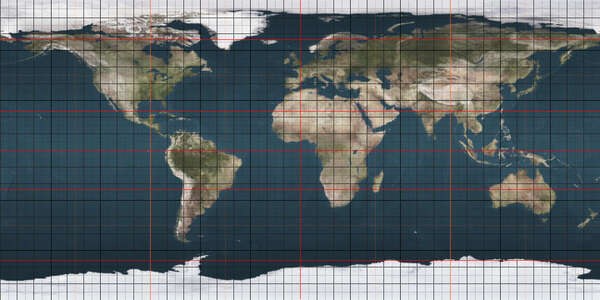100th meridian west
The meridian 100° west of the Prime Meridian of Greenwich is a line of longitude that extends from the North Pole across the Arctic Ocean, North America, the Pacific Ocean, the Southern Ocean, and Antarctica to the South Pole. The 100th meridian west forms a great circle with the 80th meridian east. In the United States, this meridian roughly marks the boundary between the semi-arid climate in the west and the humid continental and humid subtropical climates in the east and is used as shorthand to refer to that arid-humid boundary. The meridian coincides with the approximate center of the continental United States, and is featured prominently on the cover of the Charter of the United Nations.
From Pole to Pole
Starting at the North Pole and heading south to the South Pole, the 100th meridian west passes through:
United States

In the United States the meridian 100° west of Greenwich forms the eastern border of the Texas panhandle with Oklahoma (which traces its origin to the Adams-Onís Treaty in 1819 which settled the border between New Spain and the United States between the Red River and Arkansas River). Dodge City, Kansas lies exactly at the intersection of the Arkansas River and the 100th meridian. As first noted by John Wesley Powell in the 1870s, there is a big difference in rainfall by the different sides of the meridian. In the central Great Plains, it roughly marks the western boundary of the normal reach of moist air from the Gulf of Mexico, and the approximate boundary (although some areas do push the boundary slightly farther east) between the semi-arid climate to the west and the humid continental (north of about 37°N) and humid subtropical (south of about 37°N) climates to the east. West of the meridian, raising livestock is much more economically important than east of it, and what agriculture does exist relies heavily on irrigation. Historically, the meridian has often been taken as a rough boundary between the eastern and western United States. White settlement, spreading westward after the American Civil War, settled the area around this meridian during the 1870s.[citation needed] A sign across U.S. Highway 30 in Cozad, Nebraska, marks the place where the 100th meridian intersects with the routes of the Oregon Trail, Pony Express, transcontinental railroad, and the Lincoln Highway.
In popular culture
The song "At the Hundredth Meridian" by The Tragically Hip is about the 100th meridian west, specifically in Canada, and how it has traditionally been considered "where the Great Plains begin."[1]
| Next westward: 101st meridian west |
100th meridian west forms a great circle with 80th meridian east |
Next eastward: 99th meridian west |
See also
References
- ↑ Krajick, Kevin (11 April 2018). "The 100th Meridian, Where the Great Plains Begin, May Be Shifting". Columbia Climate School. Retrieved September 8, 2023.
